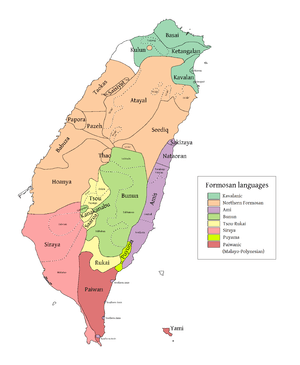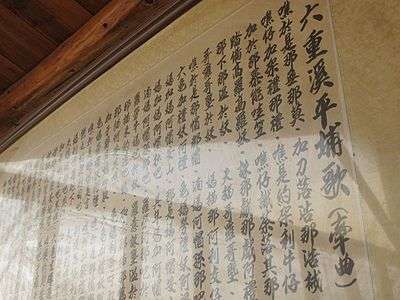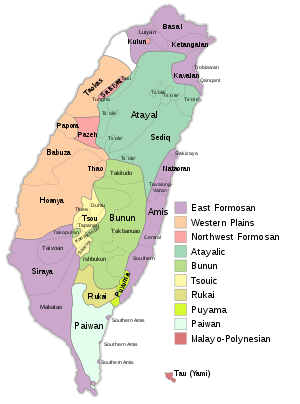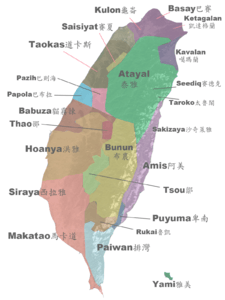Taivoan language
| Taivoan | |
|---|---|
| Rara ka maka-Taivoan | |
| Pronunciation | [taivu'an] |
| Native to | Taiwan |
| Region | Southwestern, around present-day Tainan, Kaohsiung. Also among some migration communities along Huatung Valley. |
| Coordinates | 23°06′N 120°27′E / 23.100°N 120.450°E |
| Ethnicity | Taivoan |
| Extinct | end of 19th century; revitalization movement |
|
Austronesian
| |
| Latin (Sinckan Manuscripts), Han characters (traditional) | |
| Language codes | |
| ISO 639-3 |
—[note 1] |
| Glottolog |
taiv1237[1] |
| Linguasphere |
30-FAA-bb |
 (pink) Taivoan | |
| Taivoan language test of Wikipedia at Wikimedia Incubator |
Taivoan or Taivuan, is a Formosan language spoken until the end of the 19th century by the indigenous Taivoan people of Taiwan. Taivoan used to be regarded as a dialect of Siraya, but now more evidence has shown that they should be classified as separate languages. The corpora previously regarded as Siraya like the Gospel of St. Matthew and the Notes on Formulary of Christianity translated into "Siraya" by the Dutch people in the 17th century should be in Taivoan majorly.
Classification
The Taivoan language used to be regarded as a dialect of Siraya. However, more evidences have shown that it belongs to an independent language spoken by the Taivoan people.
Documentary evidence
In "De Dagregisters van het Kasteel Zeelandia" written by the Dutch colonizers during 1629-1662, it was clearly said that when the Dutch people would like to speak to the chieftain of Cannacannavo (Kanakanavu), they needed to translate from Dutch to Sinckan (Siraya), from Sinckan to Tarroequan (possibly a Paiwan or a Rukai language), from Tarroequan to Taivoan, and from Taivoan to Cannacannavo[2][3].
"...... in Cannacannavo: Aloelavaos tot welcken de vertolckinge in Sinccans, Tarrocquans en Tevorangs geschiede, weder voor een jaer aengenomen" — "De Dagregisters van het Kasteel Zeelandia", pp.6-8
Linguistic evidence
A comparison of numerals of Siraya, Taivoan (Tevorangh dialect), and Makatao (Kanapo dialect) with Proto-Austronesian language show the difference among the three Austronesian languages in southwestern Taiwan in the early 20th century[4][5]:
| PAn | Proto-Siraya | Siraya (UM) | Siraya (Gospel) | Siraya (Kongana) | Taivoan (Tevorangh) | Makatao (Kanapo) | |
|---|---|---|---|---|---|---|---|
| 1 | *asa | *saat | sa-sat | saat | sasaat | tsaha | na-saad |
| 2 | *duSa | *ðusa | sa-soa | ruha | duha | ruha | ra-ruha |
| 3 | *telu | *turu | tu-turo | turu | turu | tuhu | ra-ruma |
| 4 | *Sepat | *səpat | pa-xpat | xpat | tapat | paha' | ra-sipat |
| 5 | *lima | *rǐma | ri-rima | rima | tu-rima | hima | ra-lima |
| 6 | *enem | *nəm | ni-nam | nom | tu-num | lom | ra-hurum |
| 7 | *pitu | *pitu | pi-pito | pitu | pitu | kito | ra-pito |
| 8 | ---
*walu |
*kuixpa
--- |
kuxipat
--- |
kuixpa
--- |
pipa
--- |
kipa
--- |
---
ra-haru |
| 9 | ---
*Siwa |
*ma-tuda
--- |
matuda
--- |
matuda
--- |
kuda
--- |
matuha
--- |
---
ra-siwa |
| 10 | --- | *-ki tian | keteang | kitian | keteng | kaipien | ra-kaitian |
In 2009, Li (2009) further proved the relationship among the three languages, based on the latest linguistic observations below:
| PAn | Siraya | Taivoan | Makatao | |
|---|---|---|---|---|
| Sound change (1) | *l | r | Ø~h | r |
| Sound change (2) | *N | l | l | n |
| Sound change (3) | *D, *d | s | r, d | r, d |
| Sound change (4) | *k
*S |
-k-
-g- |
Ø
Ø |
-k-
---- |
| Morphological change
(suffices for future tense) |
-ali | -ah | -ani |
Some examples include:
| PAn | Siraya | Taivoan | Makatao | ||
|---|---|---|---|---|---|
| Sound change (1) | *telu | turu | tuhu | toru | three |
| *lima | rima | hima | rima | five | |
| karotkot | kau | ----- | river | ||
| mirung | mi'un'un | mirun | to sit | ||
| Sound change (2) | *puNi | mapuli | mapuri | mapuni | white |
| alay | alay | anay | because | ||
| sulat | solat | sonat | book | ||
| tawil | tawil | tawin | year | ||
| Sound change (3) | *Daya | saya | daya | raya | east |
| *DaNum | salom | rarum | ralum | water | |
| sa | ra, da | ra, da | and | ||
| Sound change (4) | *kaka | kaka | aka | aka | elder siblings |
| *biRbiR | vigvig | bibi | ----- | lips | |
| ligig | li'ih | ----- | sand | ||
| matagi-vohak | matai-vohak | ----- | to regret |
Based on the discovery, Li attempted two classification trees:[6]
1. Tree based on the number of phonological innovations
- Sirayaic
- Taivoan
- Siraya–Makatao
- Siraya
- Makatao
2. Tree based on the relative chronology of sound changes
- Sirayaic
- Siraya
- Taivoan–Makatao
- Taivoan
- Makatao
Li (2009) considers the second tree (the one containing the Taivoan–Makatao group) to be the somewhat more likely one.
Lee (2015) regards that, when Siraya was a lingua franca among at least eight indigenous communities in southwestern Taiwan plain, Taivoan people from Tevorangh, who has been proved to have their own language in "De Dagregisters van het Kasteel Zeelandia", might still need the translation service from Wanli, a neighbor community that shared common hunting field and also a militarily alliance with Tevorangh[3].
Phonology[7]
Vowels
| Front | Central | Back | |
|---|---|---|---|
| Close | i, y /i/ | u /u/ | |
| Mid | e /e/ | e /ə/ | |
| Open | a /a/ | o /o/ |
Consonants
| Bilabial | Labio-dental | Dental | Alveolar | Palatal | Velar | Glottal | |
|---|---|---|---|---|---|---|---|
| Stop | p /p/ | t /t/
d /d/ |
k /k/
g /g/ |
^ /ʔ/ | |||
| Frictive | b /b/ | f /f/
v /v/ |
s /s/
z /z/ |
x /x/ | h /h/ | ||
| Sibilant | c /t͡s/
ts /t͡sʰ/ |
||||||
| Nasal | m /m/ | n /n/ | ng /ŋ/ | ||||
| Trill | r /r/ | ||||||
| Lateral approximant | l /l/ | ||||||
| Approximant | w /w/ | y /j/ |
It's likely that there were no /g/, /ts/, and /tsʰ/ in the 17th-19th century Taivoan, although Adelaar claims c preceding i or y be sibilant or affricate[8] and so could be /ts/ or /ʃ/. However, the three sounds appeared after the 20th century, especially in Tevorangh dialect in Siaolin, Alikuan, and Dazhuang, and also in some words in Vogavon dialect in Lakku, for example[9][10]:
- /g/: agang /a'gaŋ (crab), ahagang /aha'gaŋ/ or agaga' /aga'ga?/ (red), gupi /gu'pi/ (Jasminum nervosum Lour.), Anag /a'nag/ (the Taivoan Highest Ancestral Spirit), kogitanta agisen /kogitan'ta agi'sən/ (the Taivoan ceremonial tool to worship the Highest Ancestral Spirits), magun /ma'gun/ (cold).
- /t͡s/: icikang /it͡si'kaŋ/ (fish), vawciw /vaw't͡siw/ (Hibiscus taiwanensis Hu), cawla /t͡saw'la/ (Lysimachia capillipes Hemsl.), ciwla /t͡siw'la/ (Clausena excavata Burm. f.). The sound also clearly appears in a recording of the typical Taivoan ceremonial song "Kalawahe" sung by Taivoan in Lakku that belongs to Vogavon dialect[11].
The digraph ts recorded in the early 20th century may represent /t͡sʰ/ or /t͡s/:
- /t͡sʰ/ or /t͡s/: matsa (door, gate), tabutsuk (spear), tsakitsak (arrow), matsihaha (to laugh), tsukun (elbow), atsipi (a sole of the foot), tsau (dog). Only one word is attested in Vogavon dialect in Lakku: katsui (pants, trousers)[4].
Stress
It's hard to tell the actual stressing system of Taivoan in the 17th-19th century, as it's been a dormant language for nearly a hundred years. However, since nearly all the existing Taivoan words pronounced by the elders fall on the final syllable, there has been a tendency to stress on the final syllable in modern Taivoan for language revitalization and education, compared to modern Siraya that the penultimate syllable is stressed.
Numerals
Taivoan has a decimal numeral system as following:
| 1 | tsaha | 11 | saka |
| 2 | ruha | 12 | bazun |
| 3 | tuhu | 13 | kuzun |
| 4 | paha' | 14 | langlang |
| 5 | hima | 15 | linta |
| 6 | lom | 16 | takuba |
| 7 | kito | 17 | kasin |
| 8 | kipa | 18 | kumsim |
| 9 | matuha | 19 | tabatak |
| 10 | kaipien | 20 | kaitian |
| Examples of higher numerals | |||
|---|---|---|---|
| 30 | tu-tuhu kaipien | ||
| 60 | lo-lom kaipien | ||
| 99 | matuha kaipien ab ki matuha | ||
| 100 | ka'atuxan | ||
| 4,000 | paha' katununan | ||
| 5,000 | hima katununan | ||
Examples
Words and phrases

Some Taivoan people in remote communities like Xiaolin, Alikuan, Laolong, Fangliao, and Dazhuang, especially the elders, still use some Taivoan words nowadays, such as miunun "welcome" (originally "please be seated"), mahanru (in Xiaolin, Alikuan), makahanru (in Laolong) "thank you", "goodbye" (originally "beautiful"), tapakua "wait a moment".
Songs
Many Taivoan songs have been recorded and some ceremonial songs like "Kalawahe" and "Taboro" are still been sung on every Night Ceremony annually. Some examples:
Kalawahe (or "the Song out of the Shrine")
- Wa-he. Manie, he mahanru e, he kalawahe, wa-he.
- Talaloma e, he talaloma e, he kalawahe, wa-he.
- Tamaku e, he tamaku e, he kalawahe, wa-he.
- Saviki e, he saviki e, he kalawahe, wa-he.
- Rarom he, he rarom he, he kalawahe, wa-he.
Panga (or "the Song of Offerings")
- Ho i he, rarom mahanru ho i he, rarom taipanga ho i he.
- Ho i he, hahu mahanru ho i he, hahu taipanga ho i he.
- Ho i he, hana mahanru ho i he, hana taipanga ho i he.
- Ho i he, saviki mahanru ho i he, saviki taipanga ho i he.
- Ho i he, iruku mahanru ho i he, tuku taipanga ho i he.
See also
Notes
- ↑ Currently requesting, Change Request Documentation: 2018-088, ISO 639-3, SIL International
- ↑ Based on the Siraya vocabulary found in the Utrecht Manuscript written in the 17th century.
- ↑ Based on the Siraya vocabulary found in the Gospel of St. Matthew written in the 17th century.
- ↑ Attested in Siraya's Kongana community in the early 20th century.
- ↑ Attested among Tevorangh-Taivoan communities, including Siaolin, Alikuan, and Kahsianpoo, in the early 20th century.
- ↑ Attested in Makatao's Kanapo community in the early 20th century.
References
- ↑ Hammarström, Harald; Forkel, Robert; Haspelmath, Martin, eds. (2017). "Taivoan". Glottolog 3.0. Jena, Germany: Max Planck Institute for the Science of Human History.
- ↑ De Dagregisters van het Kasteel Zeelandia. 1629–1662.
- 1 2 Lee, Jui-Yuan (2015). From Single to Group: The Formation of Sideia in the 17th Century. Department of History: National Cheng Kung University.
- 1 2 Tsuchida, Shigeru; Yamada, Yukihiro; Moriguchi, Tsunekazu (1991). Linguistic Materials of the Formosan Sinicized Populations I: Siraya and Basai. Tokyo: The University of Tokyo Department of Linguistics.
- ↑ Blust, Robert; Trussel, Stephen (2018-05-12). "The Austronesian Comparative Dictionary, web edition". trussel2.com. Retrieved 2018-05-26.
- ↑ Li, Paul Jen-kuei (2009). "Linguistic differences among Siraya, Taivuan, and Makatau". In Adelaar, A; Pawley, A. Austronesian historical linguistics and culture history : a festschrift for Robert Blust. Canberra: Pacific Linguistics, Research School of Pacific and Asian Studies, Australian National University. ISBN 9780858836013.
- ↑ Alexander, Adelaar (2014). Phonology and Spelling System Reconstruction. Siraya languages study and revival seminars.
- ↑ Adelaar, Alexander (2011). Siraya. Retrieving the Phonology, Grammar and Lexicon of a Dormant Formosan Language. Berlin: De Gruyter Mouton. p. 34. ISBN 9783110252958.
- ↑ 種回小林村的記憶 : 大武壠民族植物暨部落傳承400年人文誌 (A 400-Year Memory of Xiaolin Taivoan: Their Botany, Their History, and Their People). Kaohsiung City: 高雄市杉林區日光小林社區發展協會 (Sunrise Xiaolin Community Development Association). 2017. ISBN 978-986-95852-0-0.
- ↑ 張, 振岳 (2010). 大庄平埔西拉雅族文物圖說與民俗植物圖誌 (Illustrations of Cultural Relics and Ethnobotany of Pingpu Siraya in Dazhuang). Hualian: Hualien County Cultural Affairs Bureau. pp. 8–14. ISBN 978-986-02-5684-0.
- ↑ "高雄縣大武壟群牽戲---Kalawahe(加拉瓦嘿) 六龜興隆潘安然領唱/王樹花答唱". YouTube. 2012-12-23. Retrieved 2018-05-30.

